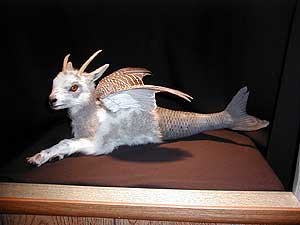|
Audio
Photos
Resources
Your Voice
|
Art that's stuffed and mounted
October 22, 2004
 |
| "Capricorn" by Serena Brewer. Brewer's sculptures use parts of dead animals to create new, magical beasts. (MPR Photo/Marianne Combs) |
Minneapolis, Minn. — Artist Serena Brewer works with dead things. She creates entirely new creatures out of the parts of old ones. The daughter of artist parents and raised on a hobby farm, Brewer finds her work completely natural.
"I consider myself an artist first and a taxidermist second," says Brewer. "When people ask me what I do, I say sculpture. It's taxidermy sculpture, it's just I'm using feather and fur rather than clay or steel."
 | |||
Brewer's work is both fanciful and disturbing. Some pieces are mythic, while others resemble animals you'd see in a freak show.
She made a chimera out of a baby goat, wings and a fish. She gave a turkey three heads and the body of a raccoon.
Brewer's pieces are meticulously detailed. Some require her to place each feather individually, and it's almost impossible to tell where one animal ends and the other begins.
The focus and attention has paid off -- Brewer's been supporting herself with this work for the past five years. People fascinated by sideshow art are big fans of hers, she has a list of regular buyers, and she's quite popular with tattoo parlors. But she's never received much attention from the press, except one time when a photo of her work was used to inspire a tabloid article.
On opening night at the Creative Electric Studios, the gallery is packed. At first glance it looks like a natural history exhibit, with stuffed animals spotlit in display cases and hanging from the wall. This is the first group show of the Minnesota Association of Rogue Taxidermists. The responses to the work vary drastically. Jean Rayder is a little creeped out by it all.
 | |||
"I definitely wouldn't want any of it displayed in my home."
Rayder's not the only one. At gallery openings free food is usually a big draw, but on this night people aren't digging into the stilton cheese with their usual gusto.
Former art historian Daniel Boone disagrees with Rayder. Rather than morbid, he finds the work inspiring.
"To me, it crosses boundaries between human and animal existence," says Boone. "It anthropomorphizes things in a way, like a natural history museum couldn't -- because it gives motives, actions, and attitudes to these animals."
Taxidermy literally means "movement of the skin." The Minnesota Association of Rogue Taxidermists is made up of Serena Brewer and two other artists who've each used taxidermy to create their own very different work.
 | |||
Scott Bibus' pieces are pretty gory at first glance. Many feature animals eating human fingers, and there's a fair amount of blood. Bibus says they are about what he calls reverse consumption.
"Because as humans our only real interaction with non-domesticated animals is through consuming them -- farming them, raising them and then eating them -- and it just kind of turns that [notion] on its head," says Bibus.
Taxidermy first became popular in the 1700s as a means of scientific categorization and education. Bibus says even early on, creative taxidermists explored how they could manipulate the animals -- turn a fish into a mermaid, or dress a bear up in a suit and top hat. Over the years, Bibus says taxidermy has lost its scientific value, replaced by zoos and documentary films.
"We don't need to have stuffed animals to show us what an animal looks like anymore," says Bibus. "So now I think the only way -- besides commercialized taxidermy and trophy taxidermy -- the only way for taxidermy to go is in an artistic [direction]. Otherwise it will die."
Bibus says taxidermy is relatively non-toxic compared to other art forms. None of these animals were killed for the purpose of making the art. Bibus says he buys most of his dead animals -- or he scavenges for roadkill.
 | |||
"It's getting to be about safe time to pick up road kill. It's a little cool, keeping things chilled," says Bibus. "The irony of roadkill collection is that when it's summer there are more animals, but they just go bad faster. It's an art form in and of itself, collecting roadkill."
The Minnesota Association of Rogue Taxidermists will hold a master class on squirrel mounting in conjunction with its show at Creative Electric Studios.
Robert Marbury doesn't use actual animals. He transforms stuffed animal toys into wild beasts. He uses what he calls an "urbanization process." For a while, Marbury had truck drivers ride around with the animals tied to their front grates.
"There's something about this quality of innocence changing, as this animal becomes dirty and 'unusable.' It's becoming feral in some sense," says Marbury. "So I try to express the feral quality of the stuffed animal by mounting them on a taxidermy mount, and trying to create a kind of confusing object -- that looks wild and scary but at the same time familiar and comforting."
While the art has a core group of dedicated fans, it has yet to appeal to a broader audience. Marbury says many people have a hard time taking humorous art seriously. And many people just aren't comfortable looking at dead things. The artists say, in a country where the majority of people eat dead things, they find that ironic.
|
News Headlines
|
Related Subjects
|
